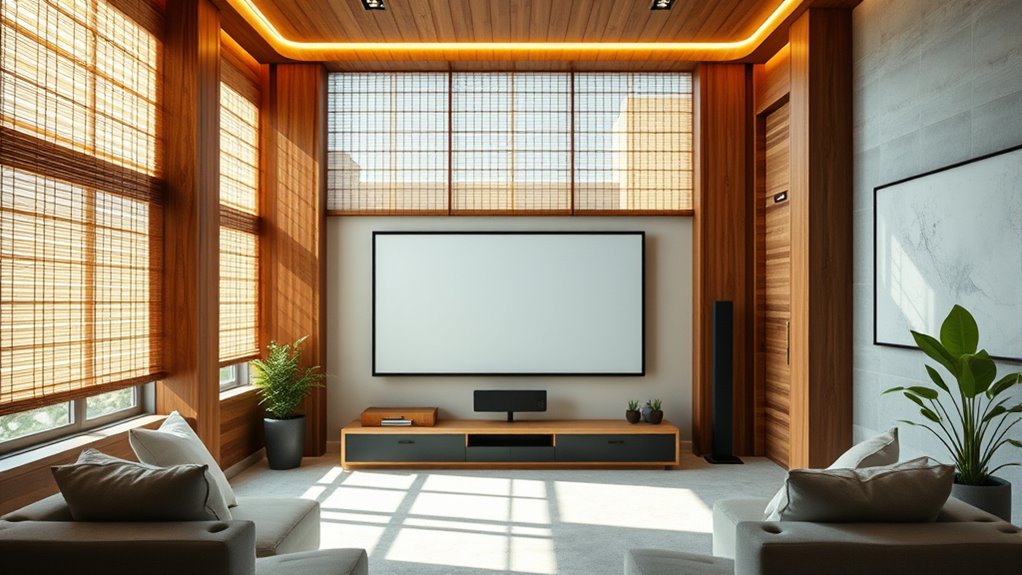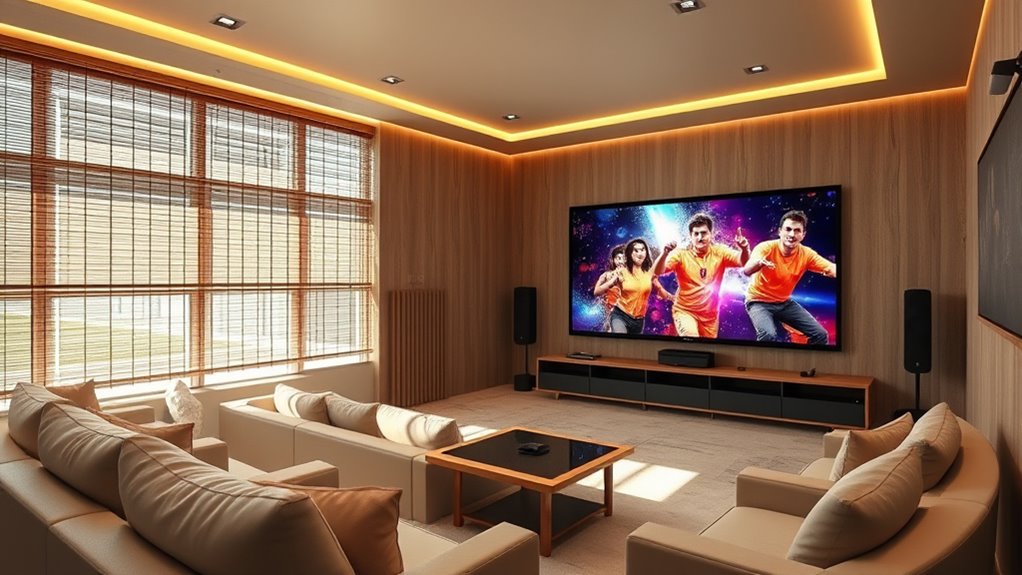To create an eco-friendly home theater, choose energy-efficient equipment like LED lighting, solar-powered projectors, and energy-saving sound systems. Opt for sustainable materials such as recycled wood for furniture and recyclable components for screens. Incorporate smart lighting and eco-conscious soundproofing made from natural, recyclable materials. By selecting renewable energy sources and eco-friendly products, you’ll reduce your environmental impact and save costs over time. Explore the options further to discover how to make your space even greener.
Key Takeaways
- Choose solar-powered projectors, screens, and sound systems to reduce electricity consumption and carbon footprint.
- Use furniture and materials made from recyclable or sustainably sourced resources to promote waste reduction.
- Incorporate LED lighting with dimming and motion sensors for energy-efficient illumination.
- Opt for soundproofing and acoustic treatments made from natural, recyclable, or renewable materials.
- Select energy-efficient technology for all home theater components to minimize environmental impact.

Are you looking to enjoy your favorite movies while reducing your environmental impact? Creating an eco-friendly home theater means choosing energy-efficient equipment and sustainable materials that align with your commitment to the planet. One of the best ways to start is by investing in solar-powered devices. Solar-powered projectors, screens, or even sound systems can considerably cut down your electricity consumption. By harnessing the sun’s energy, you’re not only reducing your carbon footprint but also saving money in the long run. These devices are becoming more accessible and reliable, making it easier for you to enjoy high-quality entertainment without guilt.
Invest in solar-powered devices to enjoy movies sustainably and save on energy costs.
In addition to solar-powered options, focusing on recyclable materials can make a big difference. When selecting furniture, cabinetry, or decorative elements, look for items made from recyclable or sustainably sourced materials. For example, you might choose seats crafted from recycled wood or plastics, which help divert waste from landfills and reduce the demand for virgin resources. For your screen or projector casing, opt for products that are designed with recyclable components, so they can be properly disposed of or repurposed at the end of their lifespan. This approach ensures your home theater not only provides entertainment but also minimizes environmental harm.
Lighting plays a key role in creating an eco-friendly space. Switch to LED bulbs, which consume a fraction of the energy of traditional incandescent lights. Some LED options are made from recyclable materials and are designed to last longer, reducing waste. Incorporate dimmable fixtures or motion sensors to limit unnecessary energy use, especially during moments when full brightness isn’t needed. Smart lighting systems can also be programmed to operate efficiently, turning off automatically when not in use. These small changes add up, making your home theater more sustainable without sacrificing comfort or convenience.
Finally, consider soundproofing and acoustic treatments made from natural, recyclable materials. Wool, recycled cotton, or plant-based foams can help improve sound quality while reducing the environmental impact of your setup. These eco-friendly materials often come from renewable sources and can be recycled or composted at the end of their life cycle. Additionally, utilizing energy-efficient technology in your setup can further enhance sustainability efforts. By choosing sustainable options for every element—furniture, lighting, soundproofing—you create a cohesive space that aligns with eco-conscious values.
Frequently Asked Questions
What Are the Best Energy-Saving Projectors for Home Theaters?
You should consider projectors with high brightness levels and long lamp lifespan for your home theater. Look for models that use LED or laser light sources, as they consume less energy and last longer, reducing waste. These projectors provide vivid images even in well-lit rooms, and their energy-efficient features help save on electricity. Brands like BenQ, Epson, and Optoma offer options that balance brightness and longevity, making them great choices.
How Can I Reduce Soundproofing Energy Consumption Effectively?
You can reduce soundproofing energy consumption by upgrading to high-quality soundproofing insulation, which minimizes heat transfer. Additionally, installing acoustic panels helps improve sound quality without needing extra heating or cooling, saving energy. Make sure your insulation is properly sealed and well-maintained, and consider using eco-friendly materials. These steps keep your home theater comfortable and energy-efficient, all while enhancing soundproofing performance.
Are There Eco-Friendly Options for Acoustic Treatments?
Think of acoustic treatments as a cozy blanket wrapping your space. You can choose eco-friendly wall panels made from recycled materials, giving new life to waste. Recyclable insulation options also help, trapping sound without harming the environment. These environmentally conscious choices reduce your carbon footprint while enhancing soundproofing, making your home theater both greener and more immersive. Embrace sustainable materials to create a sound environment that’s kind to the planet.
What Sustainable Materials Are Ideal for Home Theater Furniture?
You should choose sustainable materials like bamboo furniture and recycled fabrics for your home theater. Bamboo is a fast-growing, renewable resource that offers durability and a sleek look. Recycled fabrics, used in cushions or upholstery, reduce waste and add eco-friendly comfort. These options help you create a stylish, environmentally conscious space while minimizing your carbon footprint. Opting for these materials supports sustainability without sacrificing style or function.
How Do Smart Home Systems Optimize Energy Use in Theaters?
Smart home systems optimize your theater’s energy use by integrating smart lighting and energy monitoring. You can set schedules for lights to turn off when not needed, reducing waste, and monitor real-time energy consumption to identify inefficiencies. These features help you save on electricity, lower your environmental impact, and create a more sustainable home theater experience effortlessly, all while maintaining ideal viewing comfort.
Conclusion
Think of your eco-friendly home theater as a lush, thriving garden. By choosing energy-efficient equipment and sustainable materials, you nurture a space that blooms with responsibility and innovation. Each mindful decision is like watering a plant, helping your environment flourish while enjoying your favorite movies. Together, you create a harmonious sanctuary where entertainment and sustainability grow side by side, proving that a greener home theater isn’t just a dream—it’s a beautiful, ongoing journey.















